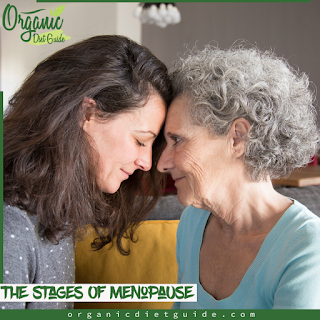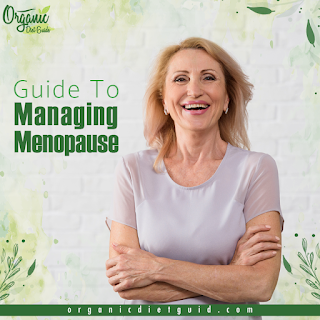Guide to Managing Menopause |The Quick Guide To Managing Menopause
List of Perimenopause Symptoms :
|
Guide to Managing Menopause |The Quick Guide To Managing Menopause |
Hot flashes
Breast tenderness
Worsening of premenstrual syndrome
Lower sex drive
Fatigue
Irregular periods
Vaginal dryness
Urine leakage when coughing or sneezing
Urinary urgency
Mood swings
Trouble sleeping
Periods are very heavy or have blood clots
Periods last several days longer than usual
Spotting between periods
Spotting after sex
Periods happen closer together
Different sizes of tampons.
Secret Anabolic Recipes | Cook Healthy | Muscle Building Meals
Signs of Menopause: Period Changes
With approaching menopause, a woman’s menstrual periods may change. They may get shorter or longer, lighter, or heavier.
The interval between periods may increase or decrease. During perimenopause, it is common for women to have a period after going several months without one.
It can take years of irregular periods before a woman reaches menopause. Pregnancy is possible during perimenopause until a woman has had a full year without periods.
If you have concerns about changes in your periods, talk with your doctor. Sometimes, conditions other than menopause can also cause changes in your period.
Menopause Symptoms: Hot Flashes
Hot flashes are a common symptom around the time of menopause. A hot flash is a feeling of warmth that tends to be concentrated around the face and neck.
It can cause flushing or reddening of the skin in these areas as well as the chest, arms, or back.
Hot flashes vary in their intensity and can be followed by sweating and/or chills. Night sweats, waking up drenched in sweat a night, may also occur during hot flashes.
How Long do Hot Flashes Last?
Hot flashes last anywhere from 30 seconds to 10 minutes, and they may start before menstrual irregularities.
Hot flashes may last up to 10 years, but 80% of women will not have any hot flashes after five years.
The exact cause of hot flashes is unknown, but they are most likely linked to the hormonal and biochemical changes brought on by decreasing estrogen levels.
Women can help reduce the symptoms of hot flashes by dressing in light layers, exercising regularly, using a fan, managing stress, and avoiding spicy foods.
Along with menopause, women experience lower levels of the hormone estrogen.
|
Guide to Managing Menopause |The Quick Guide To Managing Menopause |
One of the effects of lowered estrogen levels is a decrease in blood supply to the vagina, which causes vaginal dryness.
This can result in painful or uncomfortable intercourse. Water-soluble lubricants can help overcome this problem.
If lubricants are not effective, contact your doctor. Vaginal creams and suppositories can be prescribed to ease vaginal dryness.
Another effect of hormonal changes is a change in libido or sex drive. This may improve or worsen, but it is important to remember that other factors besides menopause can affect libido.
Stress, sleep disturbances, medications, and anxiety can all affect sex drive. Your doctor can help you find ways to manage the changes in your sex drive if they occur.
Finally, although fertility ends at menopause, women of all ages are still susceptible to STDs, so safe sex is still important.
Secret Anabolic Recipes | Cook Healthy | Muscle Building Meals
Menopause Treatment for Severe Symptoms
Hormone therapy can help alleviate many of the troublesome symptoms of menopause.
Low-dose oral contraceptive (birth control) pills are one option for perimenopausal women to help treat irregular vaginal bleeding and relieve hot flashes.
Local vaginal hormone treatments can be applied directly to the vagina when treating symptoms of vaginal estrogen deficiency.
Types of hormone therapy treatments.
Menopause Treatment: Hormone Therapy
Hormone therapy is used to control the symptoms of menopause. This treatment consists of estrogen, or a combination of estrogens and progesterone, administered via pill, patch, or spray.
Long-term use of hormone therapy has been associated with an increased risk of heart attacks, strokes, and breast cancer, so it is recommended that the lowest dose of hormones that are effective be taken for the shortest time possible.
There are a number of different types of prescription hormone therapies, and your doctor can help you find the best solution if you require this treatment.
Menopause Treatment: Bioidentical Hormone Therapy
The term “bioidentical” hormone therapy has been used to refer to hormones derived from plants prepared individually for patients at compounding pharmacies.
Some FDA approved prescription products are also “bioidentical” in the true sense of the word. Some doctors feel that compounded “bioidentical” hormone products are safer, but the US FDA does not approve these products.
Menopause Treatment: Natural Remedies
Many women try alternative treatments for menopausal symptoms. Certain botanicals, or herbal supplements, are advertised to treat hot flashes and other menopause symptoms. However, the FDA does not regulate herbal supplements, so they may not always be safe.
Herbal Supplements to Ease Menopause Symptoms
- PhytoestrogensBlack cohosh
- Dong Quai
- Evening primrose oil
- Ginseng
- Kava
- Red clover
- Vitamin E
Menopause Health Risks
Health risks associated with menopause include a greater risk of heart disease and osteoporosis. Heart disease remains the number one cause of death for women in the United States.
It is important to make sure blood cholesterol, blood pressure, and blood sugar are at normal levels. Cholesterol levels at the time of menopause may fluctuate, causing HDL (good cholesterol) to go down and LDL (bad cholesterol) to go up.
These changes may result in a heart attack or stroke. Declining estrogen levels may be partly to blame, but hormone therapy is not recommended for postmenopausal women to decrease these risks because it is associated with health risks of its own.
Menopause may also have an active role in osteoporosis, a condition in which bones become very weak and can break easily. Estrogen is important in building new bone.
Lifestyle Changes to Improve Your Cholesterol
The decrease in estrogen during menopause makes women susceptible to osteoporosis. It is very important to build as much bone density as possible before age 30.
Preserving bone density can be done by consuming foods high in calcium, such as milk and milk products. Vitamin D is also important because it helps the body absorb calcium.
Menopause and Good Nutrition
It’s never too late to start living a healthy lifestyle. Regular checkups should include a measurement of cholesterol, blood sugar, and blood pressure.
Be sure not to skip routine preventive screenings such as mammograms. Consuming plant-based foods that have isoflavones (plant estrogens) may slightly increase estrogen levels because the plants act like a weak form of estrogen.
Best Diets Weight loss Diet plans
Soy is an example of a food that contains isoflavones and may relieve menopause symptoms.
Women also tend to have low levels of calcium and iron. Getting enough calcium and iron is extremely important for women transitioning through menopause.
You can work with your doctor to establish a plan for a healthy lifestyle including a nutritious diet, physical activity, and stress management skills.
The simple lifestyle shifts in the Eat Sleep Burn ugly belly fat…
Diet and Nutrition for Menopausal Women
Eat approximately 1,200 milligrams of calcium each day
Eat approximately 9 milligrams of iron each day
Eat approximately 21 milligrams of fiber each day
Eat 1 ½ cups of fruit and 2 cups of vegetables each day
Read and understand food labels
Drink plenty of water
Cut back on fatty foods
Limit sugar and salt intake
 |
| Guide to Managing Menopause |The Quick Guide To Managing Menopause |

